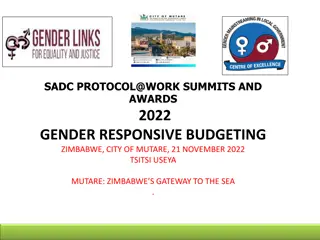Gender-Responsive Monitoring in Agriculture Adaptation Planning
Gender-responsive monitoring is essential in agricultural adaptation planning to assess impacts, promote gender equality, and empower women, men, girls, and boys. It involves developing indicators, collecting and analyzing gender-disaggregated data, and communicating findings to enhance decision-making and resource allocation.
Download Presentation

Please find below an Image/Link to download the presentation.
The content on the website is provided AS IS for your information and personal use only. It may not be sold, licensed, or shared on other websites without obtaining consent from the author. Download presentation by click this link. If you encounter any issues during the download, it is possible that the publisher has removed the file from their server.
E N D
Presentation Transcript
5.1: Gender-responsive monitoring and indicators Gender in Adaptation Planning for the Agriculture Sectors Training workshop [Name of presenter] [Date]
Learning outcomes Explain what issues are tracked as part of gender-responsive monitoring of adaptation. Explain Identify data sources for gender-responsive monitoring and key steps in measuring gender-related changes. Identify Design gender-responsive indicators for monitoring gender in agricultural adaptation plans and projects. Design
Part 1. Monitoring The monitoring phase of adaptation planning involves tracking adaptation options, policies and plans to verify whether they are achieving desired targets. An adaptation monitoring framework, also known as a results-based framework, defines in measurable terms the goal, outcomes, outputs, activities and inputs of a plan or policy. Existing frameworks can be utilized and elaborated on for the purpose of monitoring adaptation-related issues in agriculture.
Common terms used in monitoring Goal/impact Outcome Output What will be achieved ultimately in agriculture with regards to adaptation? Where will adaptation in agriculture be in five years? What will adaptation programs or policies provide? Activities Inputs What will be done to produce outputs? What financial, human and material resources are needed to implement activities?
Adaptation monitoring framework To track progress over time Used for a variety of reasons enhancing learning on adaptation, including in the long term assessing effectiveness of what works and what doesn t flexible management and adjustment of adaptation under climate uncertainty accountability to national decisionmakers and donors compliance with national and international reporting requirements, including UNFCCC
Gender-responsive monitoring An ongoing effort to assess impacts of a project or plan for women, men, girls and boys and the contribution of a project or plan to advancing gender equality and empowerment. To carry out gender-responsive monitoring: develop gender-responsive indicators as part of the monitoring plan gather, record and validate information (including sex-disaggregated data) analyse the data with a focus on gender equality outcomes (How are men and women affected? Who benefits? Who influences decisions? Who uses and controls assets and resources?) communicate and use the information
Why track gender as part of an adaptation monitoring framework? Useful for exposing inequalities improving understanding of why changes happen for different groups tracking the performance of partners holding stakeholders accountable for meeting gender-related When gender issues are monitored, including both the outcomes for different groups of people and changes at institutional level, it is possible to determine the extent to which a project or plan is contributing to transformative change and adjust if it is not meeting its targets.
What gender issues of adaptation should be monitored? When measuring the process of adaptation When measuring adaptation outcomes When measuring an increase in adaptation capacity Track % women, men who report increased access to financial resources and knowledge about climate change impacts, or report increased participation in farmers groups, or more sharing of decision-making at household level. Track an increase in water availability for both men s and women s responsibilities during drought at sub-national level as a result of women and men employing labour- reducing adaptive practices like rain water harvesting. Track advancement in implementing policies and plans with equitable participation and influence by women and men
Key considerations for carrying out gender- responsive monitoring Beneficiaries have a role to play in setting baselines and collecting data Commitment needed from numerous actors to contribute data and analysis Competencies may need to be strengthened
Part 2. Indicators An indicator is a measurable variable that helps assess the current situation and track change over a period of time. Gender indicators (GIs) (also referred to as gender-sensitive indicators or gender-responsive indicators) measure gender-related changes over time expressed as a measurement, number, opinion or perception based on quantitative or qualitative data express outcomes for different groups or progress toward gender equality against a baseline developed through an inclusive process
Types of indicators Quantitative indicators Qualitative indicators based on quantifiable data, often collected through a survey, and are usually expressed as numbers or percentages e.g. number/percentage of farmers adopting climate-resilient livestock practices by age and sex, or the percentage of female adaptation committee members measure quality of perceptions and experiences, as well as behaviour and attitudes, and are based on data collected through participatory methods e.g. growth in knowledge and skills on climate change in the sector, by sex
Formulating gender indicators Are the objectives of the plan or project gender-responsive? Do the proposed activities address the needs and priorities of both women and men and address the gender issues that have been identified in a gender analysis? Is there sex-disaggregated data to use in relation to the goals? Which indicators will tell us whether we have undertaken the activity or reached the objective? Are they written to guarantee that data will be disaggregated by sex (and other relevant socioeconomic variables)? What is the target and time frame? Is the additional data needed to track the indicators easy to collect, use and understand? Adapted from Murray (2019b)
Example Resilience of rural women and men to the impacts of adaptation on agricultural livelihoods is improved. Goal/impact Policies recognize women and men as key actors in adaptation and enable them to benefit equally. Indicator: Number of gender-responsive targets included in the policy. Outcome Impact assessments of possible gender-differentiated outcomes of policy options are undertaken. Indicator: Percentage of impact assessments that include gender analysis Output























